Kyoto is arguably the most famous city in Japan. It is brimming with culture, food, gardens, temples, and thousands of memories of the old world.
Some links on this page are affiliate links. We may earn a commission if you make a purchase, at no additional cost to you.
During my recent trip to Kyoto, one particular place stood out as one of the most unforgettable – located in the center of the city is the 400 year old Nijo-jo Castle. It rises above the town locked away behind a large, white stone wall commanding a feeling of silence and peace.
This isn’t a typical Japanese castle; the main tower burned down in 1750 after being struck by lightning. What does stand is one of the most complete castle fortresses left in Japan. Untouched even by the encroaching city, it even still contains water in its moats.
The Nijo-jo Castle was originally built in 1603 after a long period of instability and civil unrest in Japan. The first 260 years of the castle’s existence were peaceful and prosperous. This Castle is especially important to the country, many of the most important events in Japanese history took place here. The beginning and ending of the Shogun era and the beginning of the current democracy that Japan is today all began here in Kyoto.
In 1871 Japan ended the feudal age, and with it, over 2,000 Japanese castles were destroyed. Between this and WWII there are only a handful of original fortified forts left within the country. The Nijo-jo Castle is one of the few which is one reason it was made a UNESCO World Heritage site in 1994.
The scale and grandeur of Nijo-jo Castle attracts attention in the heart of Kyoto. The property is located on 68 acres of manicured gardens with two concentric, square castle moats encasing the palaces within. The fortress structures display the design of the Edo period showcasing lavish architecture and dazzling, gilded interiors.
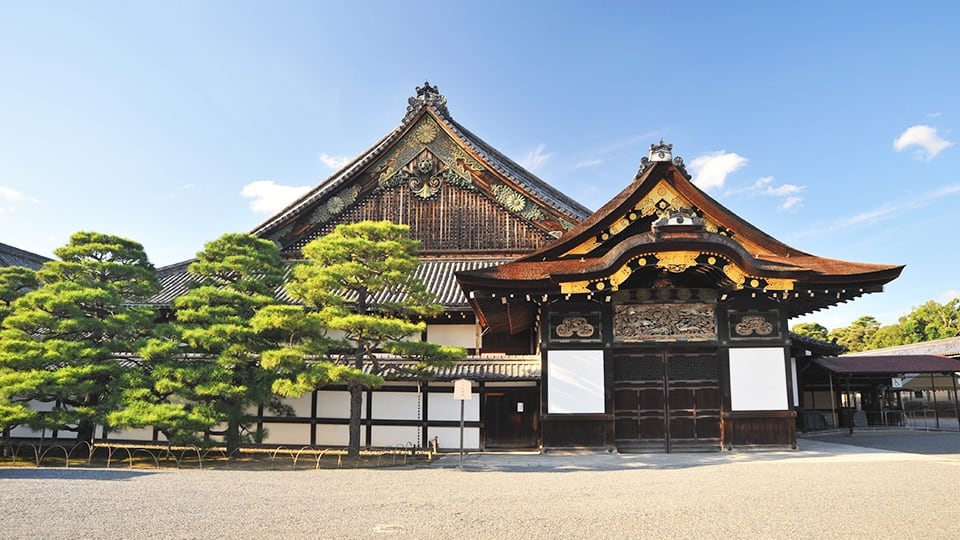
Entering Nijo-jo Castle Grounds
When first entering the gate, you’ll be impressed with the magnificence and the craftsmanship of the wooden entryway. Cranes, bamboo, and pine trees are painted and carved into the wood and decorated with thick gold gilding hanging overhead. The curled roof edges and heavy, dark timber are fitted together with great care and artistry.
Whitewashed watchtowers once manned by samurai soldiers sit on the corners of gray stone walls perched above the double moats. The smooth, dark water is now filled with long wooden boats of tourists paddling around the stone walls. Small outbuildings are found throughout the grounds that used to be storehouses, and watch towers. A few of the buildings were lost to fires throughout the years.
The Gardens of Nijo-jo Castle
The gardens are arguably one of the greatest in Kyoto. During cherry blossom season in the spring and again during the change in fall foliage, special events are held after dark with colorful lights illuminating the trees and highlighting the splendor of the architecture.
Not much is known of the original gardens from 400 years ago, but currently they’re designed to enjoy and highlight all four seasons.
Great care and planning were put into place so that visitors can experience the best of the flowers during springtime. Over 300 ornamental cherry trees were meticulously planted with early and late blooming varieties so guests may enjoy the cherry blossom season as long as possible. Just as the blooms begin to fall, multiple hedgerows of azaleas burst into fiery colors below.
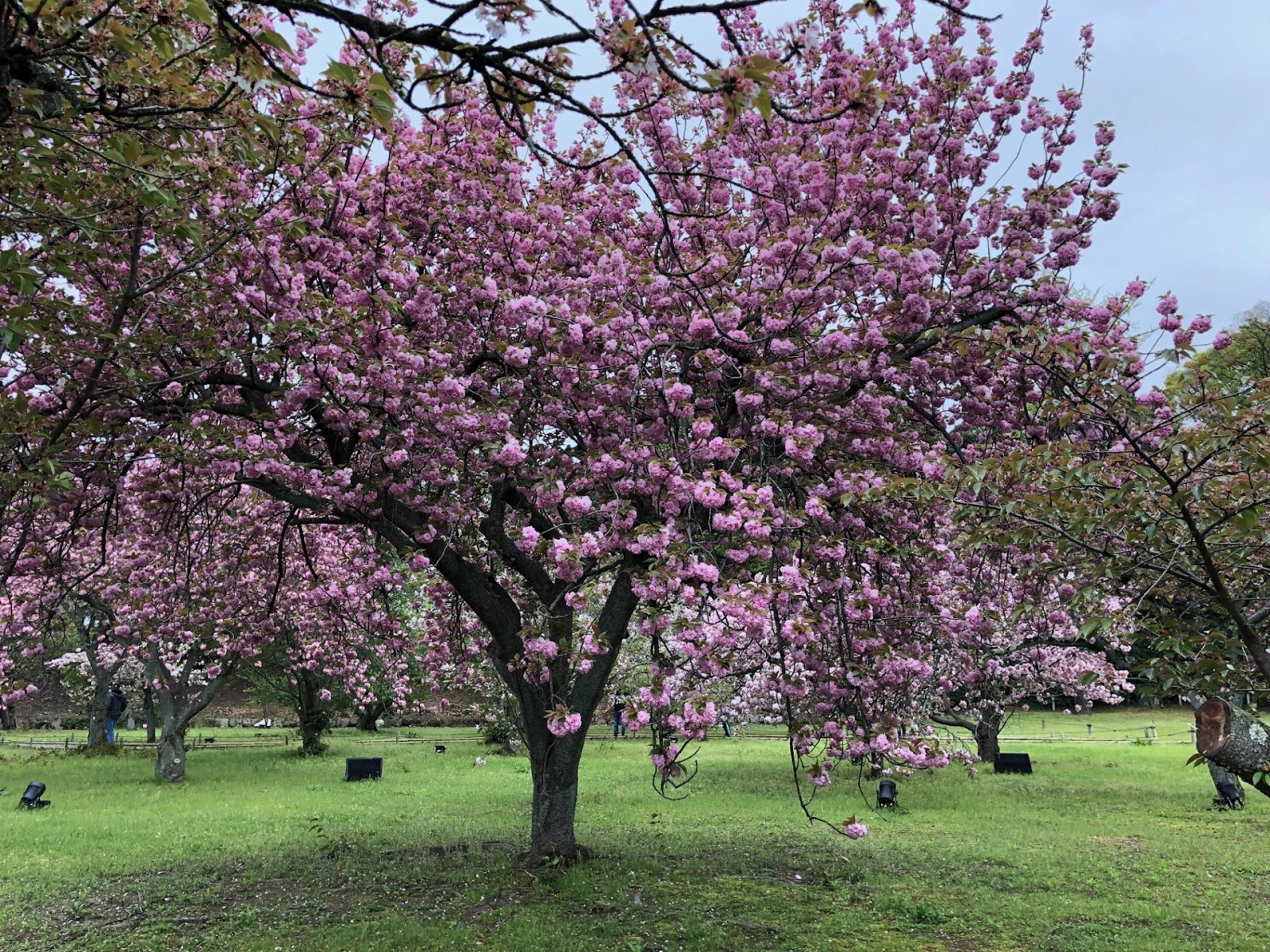
During the summer, visitors enjoy flowers from the weeping Japanese pagoda, crape myrtle, and arbors filled with morning glories. In the fall, the gardens are in flames with brilliant orange and yellow deciduous trees creating a carpet of color and a vibrant background to the perfectly pruned hedges and pines peppered throughout the property.
Ninomaru-goten Palace
Guests are able to tour the Ninomaru-goten Palace, in the entry you’ll remove your shoes, so be sure to wear socks, it’s considered polite and you’ll feel more comfortable. Photographs are not permitted inside the palace.
The residence has a unique Japanese style, it’s built entirely of wood from the foundation up with sliding paper windows. Tatami mats line the wood floors and beautiful intricate paintings cover the walls. The palace consists of 6 buildings, all connected together with 33 rooms between them. The rooms are all marked off, but guests can look in from the passageways.
The entryway to the palace contains three rooms where guests to the emperor would be escorted in to wait for him. They were usually left to wait for a while before being admitted. In these rooms, there are paintings of tigers in aggressive stances that were meant to scare the guests showing them his power and position as a great and formidable ruler.
During this period it was common to hide entry doors for bodyguards, however, in the Nijo Palace the bodyguard’s doors were large and prominent. This was another way to intimidate visitors and display his distinction.
Status determined how far you could enter the palace. The lower your status the fewer rooms you were able to enter. Each room is one step higher than the last to show that the occupants of that room are higher than the last. The shogun was always at the top level on a heightened platform than the one below. In the last position where he would sit above all others with a raised ceiling above him.
Underfoot are nightingale floors also called anti ninja. These noisy floors alerted the emperor and his guards of intruders’ presence. The squeaky floors of the palace are said to have been made unintentionally in the castle, but many palaces of the period were made with noisy floors on purpose, so the occupants could not be snuck up on without giving themselves away. The sound of the floors gave a peaceful chirping sound of a nightingale, vastly different from the creak of an old house.
Hidden doorways are located throughout the palace. They used to house sneaky samurai bodyguards ready to jump out, surprising intruders.
There are 954 paintings in all, covering the rooms from floor to ceiling. The paintings inside the palace are recreations of the originals which can be seen in the painting gallery behind glass covered cases and away from damaging sun rays.
Trees are a common thread you see throughout the palace, many of them pine trees. Pine symbolizes longevity as they are always the same throughout the seasons, unlike deciduous trees that lose their leaves and show the passage of time. The four seasons are represented throughout the grounds with cherry trees in bloom, irises, fans, chrysanthemums, hawks, and a painting of the Nijo castle and grounds itself among others. Each painting has a brilliant, golden background.
Outside the palace, you’re greeted with the Ninomaru Garden, it’s a classic Zen garden with a small pond surrounded by stones and pines. An island in the center represents paradise with smaller islands surrounding it representing longevity, all encompassed by the life-giving force and serenity of water.
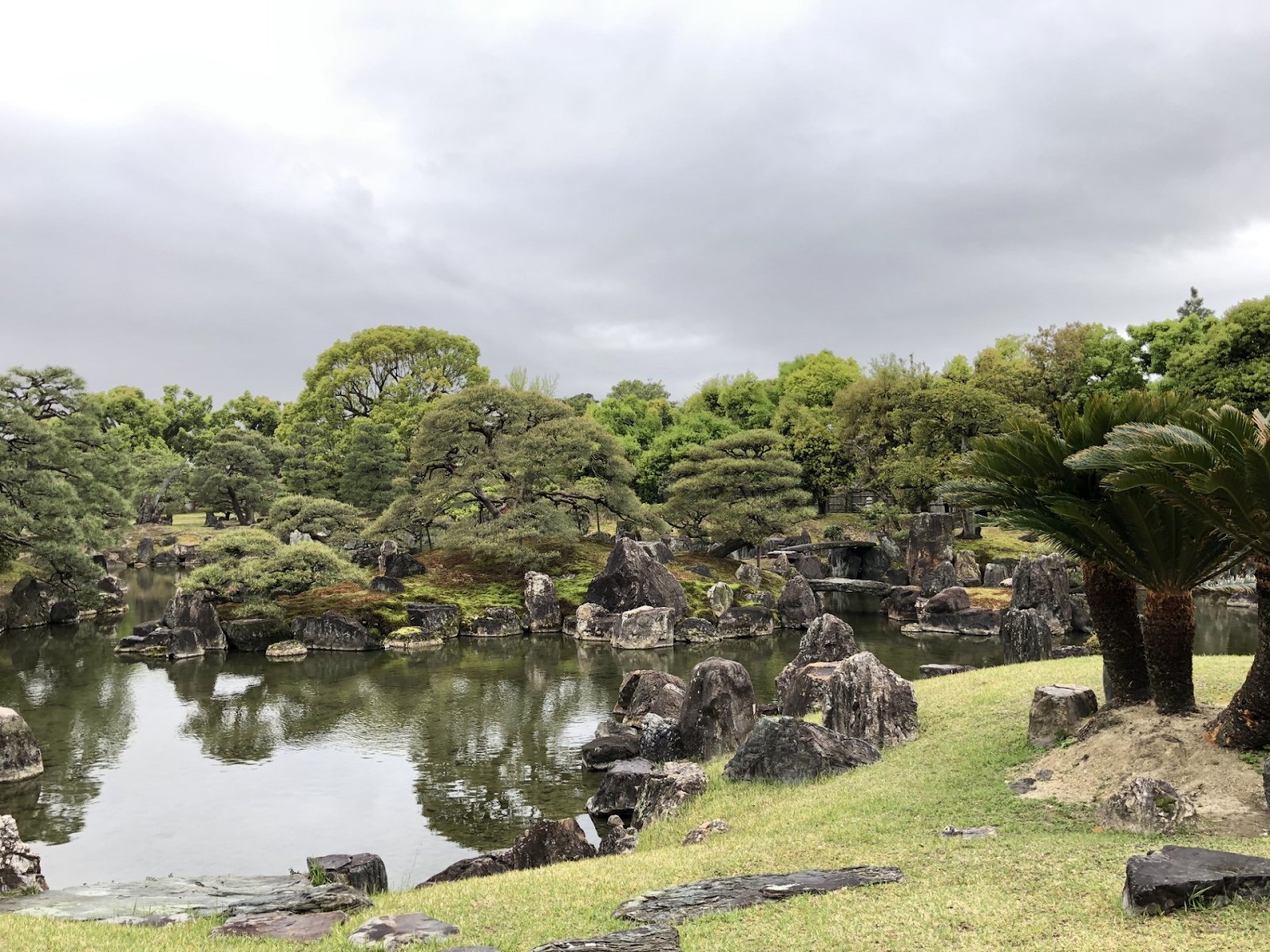
Honmaru-goten Palace is another stately home located within the second concentric inner moat; this structure is currently under renovation, but is projected to be finished this year. It generally isn’t open to the public.
The Honmaru Palace showcases one of the few original Edo period architectural styles that still exists today. It was originally a home on the Kyoto Imperial Palace grounds, but was moved to this location in 1894. The original palace built on this location was lost in a fire in 1788. It was later rebuilt in 1866, but again, it was demolished in 1881.
Though the Honmaru-goten Palace is generally closed to the public, guests are able to walk around the area and climb the stairs to the former castle keep that looks over the castle grounds and moats from above.
Getting to the Nijo-jo Castle
Walking
Kyoto is a walkable city. If you have time, you’ll see lots of pretty sites along the way.
Bus
The city bus is easy to use and is more economical than the subway. The Raku bus is an express line that hits all the tourist destinations. It costs 260 yen to ride one way or 700 yen for an all day, unlimited pass. You can buy bus passes at the main Kyoto train station at the tourist information center. You can also buy passes on the bus, but they sometimes sell out. Buses are entered through the rear and exited through the front where you will pay the fare just before exiting.
Take the 101 bus loop that runs North South to get to Nijo-jo Castle.
Subway
Head West on the Tozai Line, the Nijojo-mae stop is the closest and will bring you right to the corner of the grounds. You’ll see the castle wall when exiting the train station. You’ll come out at the South East corner of the wall.
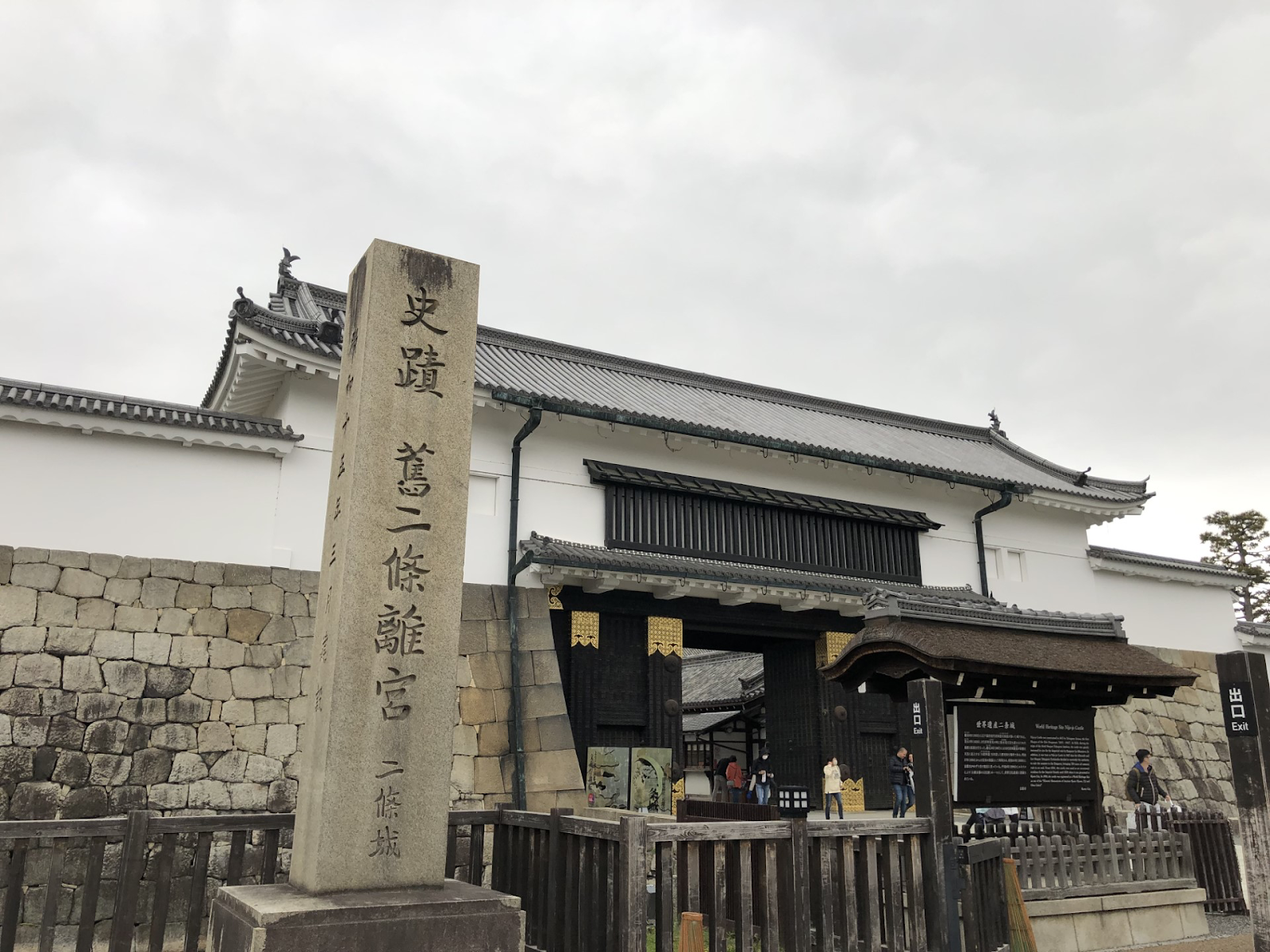
Enter through the Higashi Otemon, the Grand East Gate of the Wall where you can buy tickets at the kiosk.
Opening hours are 8:45-16:00 The doors close and everyone is asked to leave at 17:00
Ticket prices and information on guided tours can be found here.
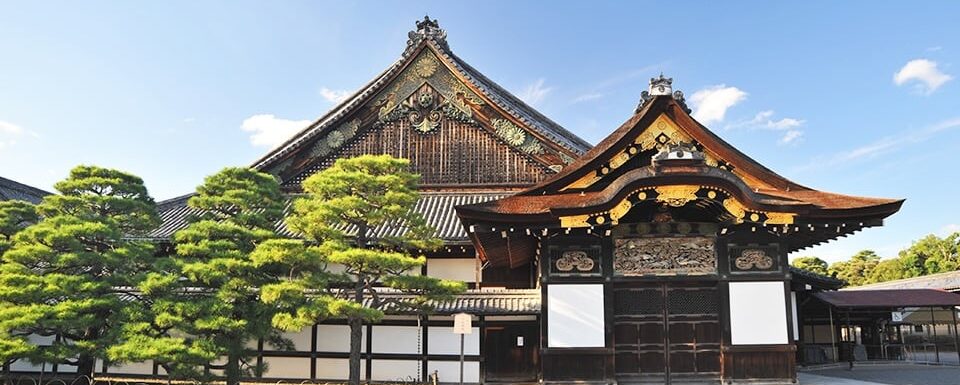
Leave a Reply